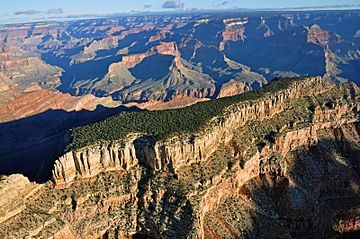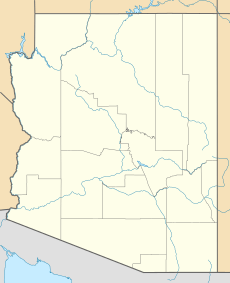Diana Temple (Grand Canyon) facts for kids
Quick facts for kids Diana Temple |
|
|---|---|

Aerial view of southeast aspect
|
|
| Highest point | |
| Elevation | 6,683 ft (2,037 m) |
| Prominence | 412 ft (126 m) |
| Isolation | 4.93 mi (7.93 km) |
| Parent peak | Mencius Temple (7,001 ft) |
| Geography | |
| Location | Grand Canyon National Park Coconino County, Arizona, US |
| Parent range | Coconino Plateau Colorado Plateau |
| Topo map | USGS Piute Point |
| Type of rock | limestone, sandstone, mudstone |
Diana Temple is a tall peak in the Grand Canyon, located in northern Arizona, USA. It stands 6,683 feet (2,037 meters) high. This impressive summit is about nine miles northwest of Grand Canyon Village. It is also just northeast of Mescalero Point.
Other nearby peaks include Pollux Temple to the northwest and Marsh Butte to the east-northeast. Vesta Temple is located one mile south. Diana Temple rises almost 4,300 feet (1,310 meters) above the Colorado River. This happens in a distance of less than two miles.
Diana Temple gets its name from Diana. She was the goddess of the hunt and the moon in Roman mythology. Clarence Dutton started the tradition of naming Grand Canyon features after gods and goddesses. The U.S. Geological Survey officially adopted the name in 1908. This was done by the U.S. Board on Geographic Names. In the early 1900s, this flat-topped mountain was sometimes called "No Mans Land." Diana Temple is in a cold semi-arid climate zone. This means it gets little rain and has cool winters.
What is Diana Temple Made Of?
The top of Diana Temple is covered with trees. It is made of a rock called Permian Kaibab Limestone. Below this, you find cream-colored Permian Coconino Sandstone. This sandstone forms steep cliffs. It is one of the youngest rock layers in the Grand Canyon. This sandstone was formed about 265 million years ago from ancient sand dunes.
Underneath the Coconino Sandstone is a reddish, sloping layer. This is the Permian Hermit Formation. Below that is the Pennsylvanian-Permian Supai Group. Even further down, you can see the distinct cliff-forming Mississippian Redwall Limestone. Then comes the Cambrian Tonto Group. Finally, at the bottom, near the Colorado River, are the ancient Paleoproterozoic Vishnu Basement Rocks.
Rainwater flows off Diana Temple in two main directions. On the north side, it drains into Slate Creek. On the south side, it flows into Topaz Canyon. Both of these eventually reach the Colorado River.
Images for kids






